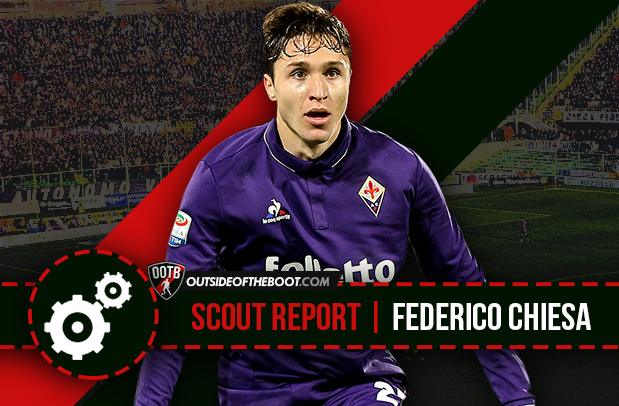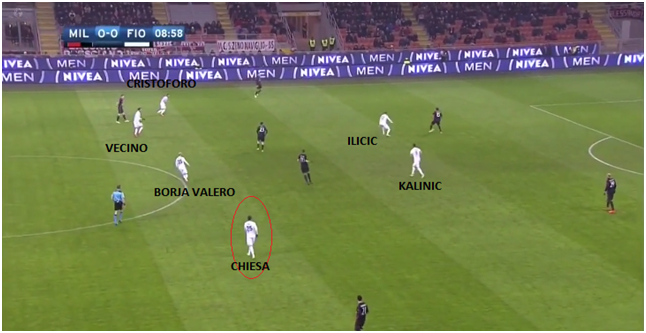Simone Torricini writes a detailed scout report about the Fiorentina and Italy winger, Simone Torricini.
Before the current season, when people talked about Italian attacking youngsters, the most common names were usually those of Andrea Belotti, Federico Bernardeschi and Domenico Berardi. According to what they have displayed so far in their career, all three will probably take part of Italy’s attack during the next seven/eight years. But they will not be alone, as since last August another great Italian youngster has grown so quickly that his manager started deploying him in the regular starting XI after only hundred days since the beginning of the season – his first as a pro.

His name is Federico Chiesa, and he is considered to be one of the best Italian wingers around despite playing only 30 Serie A matches since the beginning of his career. Born in Liguria when his father Enrico played for Sampdoria, but brought up in Florence, Federico is quite different from the old-fashioned winger. It’s also for this reason that it will be particularly interesting to take a look at his story, his features and his style of play within the team.
Who is Federico Chiesa?
Born in Genova, Italy on the 25th of october 1997, Chiesa began his career in Florence when he was only five years old. He played for U.S. Settignanese, a small club located on the outskirts of the city but quite famous because of its partnership with A.C. Milan and a good tradition regarding its coaches. After spending five years there, when he was 10, Chiesa entered the youth sector of Fiorentina. According to those who have known the youngster since that period, he had never been the starlet of the various youth selections; instead, he suffered a lot and often sat on the bench.
Talent Radar Accolades
Then, after his second year with the Primavera of the Viola, Chiesa was invited to the first team led by Paulo Sousa in view of the summer training camp. During its first part Fiorentina’s most important players were competing for the European Championship or for the Copa America, so several members of the Primavera were able to join the first team as Chiesa did, but by the end of July Sousa was forced to choose who would have remained within the first team and who wouldn’t. And, against all odds, Chiesa belonged to the small group of youths that Sousa decided to definitively keep with him.
He was immediately employed by the Portuguese during the first Serie A match of the 2016/17 season, when Fiorentina were hosted by their great rivals Juventus. Chiesa made his debut with a huge amount of pressure on himself: despite showcasing an incredible aggressiveness, he didn’t play so well, and Sousa replaced him at the end of the first half. Anyway, after a couple of months during which he never played – or he played only five, ten minutes per game – Chiesa had other chances to demonstrate his value and he quickly became one of the icons of his team.
What is his style of play?
We’ve just talked about Chiesa’s short career until now, but we’ve not talked about his style of play and his features. I have to specify that he’s a winger. Unfortunately, nowadays the concept of the modern winger has changed a lot compared to the past: nowadays, saying “He’s a winger” is not so different from saying “He’s a defender”. So, the logical question would be the following: “What type of winger is he?”.
Unlike his father, who preferred playing on the opposite side, Federico acts as a right winger within a system which has a real double-face. During the offensive phase, he works as the right wingback of a 3-4-2-1, while during the defensive phase, he has to help the right back and the system changes to a 4-2-3-1. Chiesa is quite good in acceleration and pace (even if he’s not that type of winger who usually likes being served by deep long balls) and he likes to link up play with his teammates, but also choosing personal initiatives to create numerical superiority on the right wing. In general, apart from the action developed in the final third, Chiesa plays along the sideline.

From this picture we can observe Chiesa’s position on the field. The situation is a bit peculiar, as the team is bringing pressure (against A.C. Milan, during a match last February), but the 4-4-2 formed by Fiorentina’s player allows us to see how Chiesa’s position never changes.
What are his strengths?
Chiesa is 1.75 m tall and weighs 70 kg, so physique is not his main strength. What helps him against his opponents is another quality: the aggression of which we talked about just a couple of paragraphs above. The same aggression that Fiorentina’s fans appreciate a lot, in particular during a season in which the Viola are playing under their standards – they are fighting with very little hopes for a place in the next Europa League. Chiesa is not an incredible winger from an aesthetic point of view: if I had to put him in a Serie A wingers’ ranking he would probably belong to the top ten, but surely not in the first positions. Anyway he’s only 19, and the huge improvements he made since his debut in August makes me think that in the following years he could reach a higher level in terms of pure technical ability.
He has an incredible ease of run for a player of his age, and the challenging role that Sousa gave him is surely an aspect which – as with Bernardeschi during the last season – could help Chiesa throughout his career. It’s difficult to say now if he could be more useful for the team if he played in a more advanced and central position because, considering all the attacking options between which Sousa can choose, he has rarely played there.
What is quite obvious observing him (during a match, but also through his best-performance videos) is that Chiesa has an excellent shot, both powerful and accurate enough. He has scored only 3 goals during this season (with an average of 2 shots per game), but it’s not a worrying rate considering the fact that he shoots after strenuous actions, and often from outside of the penalty box.
He’s also very good in passing, as he plays with an average successful pass rate equal to 84.7%.
Better, for example, than those of Napoli’s winger Callejon (84.3), Lazio’s winger Felipe Anderson (75.3) and Inter Milan’s winger Antonio Candreva (79.6).
Although – we must say it – between them Chiesa is the worst in terms of key-passes: only 1.2, while the others make 1.8, 2.1 and 1.8 respectively. This aspect derives from the differences between Fiorentina’s style of play, which is slower and rarely contemplates actions based only on the offensive transitions, and those of the other teams I mentioned above.
What are his weaknesses?
They are essentially two: he has to improve his defensive phase and his “feeling” with the ball. At the end of the match, in fact, he’s usually the player who loses most possession – even if he’s also the one who takes more initiative. About the first point: several times, during the current season, Chiesa has found difficulties in correctly maintaining his position both in the offensive and in the defensive phase. When Fiorentina played at the Olimpico against Roma (the Viola lost 4-0 after playing probably their worst match of the season) Chiesa was employed, as always, on the right wing, but he never helped Sanchez – who played as right back. Obviously the main worries for the team came from that side.

It’s hard in general to immagine how fast he could grow because of the particular context within which he plays. Definitely, Chiesa is surely one of the best Italian youngsters nowadays, and according to many he will become one of the leaders of Italian National team in the future. But to judge him completely we should observe his next season (perhaps his next two seasons), to understand if, with the increase of experience and age, he will be able to limit all his weaknesses. Or at least the most important ones.
Read all our Scout Reports here
- Scout Report: Sergej Milinkovic-Savic | Lazio’s imposing midfielder - September 3, 2017
- Serie A’s 10 Young Breakthrough Players to Watch in 2017-18 - August 17, 2017
- Scout Report: Lorenzo Pellegrini | Sassuolo’s offensive mezzala - May 2, 2017
























































